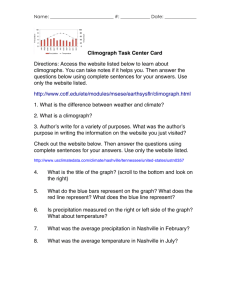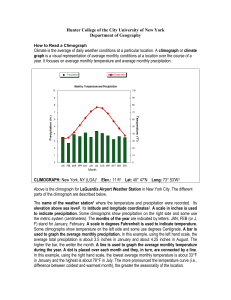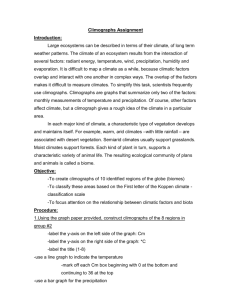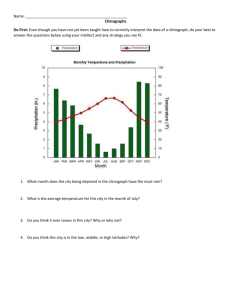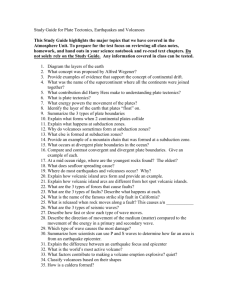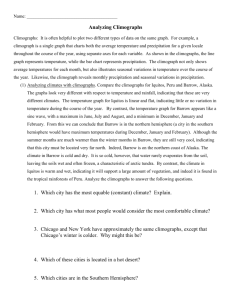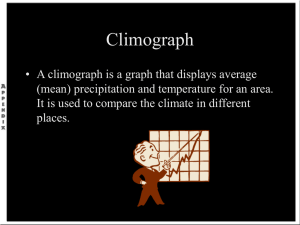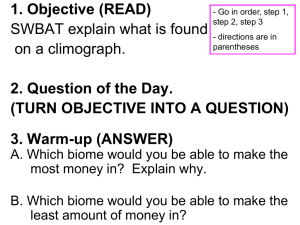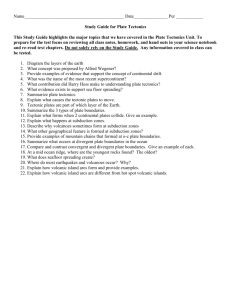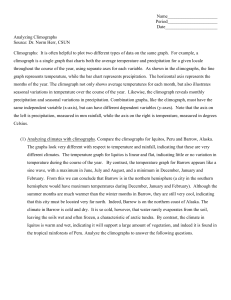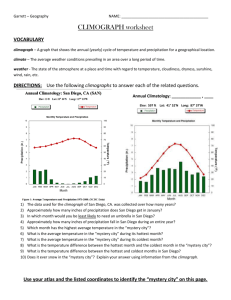Lab J – World Climate Zones
advertisement
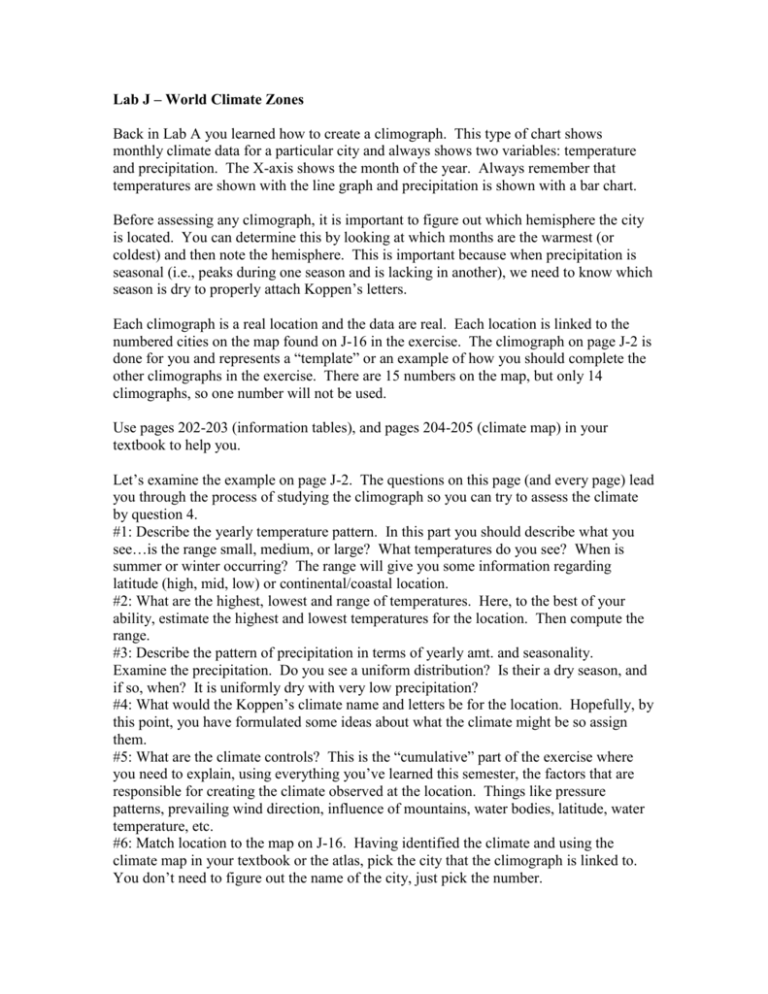
Lab J – World Climate Zones Back in Lab A you learned how to create a climograph. This type of chart shows monthly climate data for a particular city and always shows two variables: temperature and precipitation. The X-axis shows the month of the year. Always remember that temperatures are shown with the line graph and precipitation is shown with a bar chart. Before assessing any climograph, it is important to figure out which hemisphere the city is located. You can determine this by looking at which months are the warmest (or coldest) and then note the hemisphere. This is important because when precipitation is seasonal (i.e., peaks during one season and is lacking in another), we need to know which season is dry to properly attach Koppen’s letters. Each climograph is a real location and the data are real. Each location is linked to the numbered cities on the map found on J-16 in the exercise. The climograph on page J-2 is done for you and represents a “template” or an example of how you should complete the other climographs in the exercise. There are 15 numbers on the map, but only 14 climographs, so one number will not be used. Use pages 202-203 (information tables), and pages 204-205 (climate map) in your textbook to help you. Let’s examine the example on page J-2. The questions on this page (and every page) lead you through the process of studying the climograph so you can try to assess the climate by question 4. #1: Describe the yearly temperature pattern. In this part you should describe what you see…is the range small, medium, or large? What temperatures do you see? When is summer or winter occurring? The range will give you some information regarding latitude (high, mid, low) or continental/coastal location. #2: What are the highest, lowest and range of temperatures. Here, to the best of your ability, estimate the highest and lowest temperatures for the location. Then compute the range. #3: Describe the pattern of precipitation in terms of yearly amt. and seasonality. Examine the precipitation. Do you see a uniform distribution? Is their a dry season, and if so, when? It is uniformly dry with very low precipitation? #4: What would the Koppen’s climate name and letters be for the location. Hopefully, by this point, you have formulated some ideas about what the climate might be so assign them. #5: What are the climate controls? This is the “cumulative” part of the exercise where you need to explain, using everything you’ve learned this semester, the factors that are responsible for creating the climate observed at the location. Things like pressure patterns, prevailing wind direction, influence of mountains, water bodies, latitude, water temperature, etc. #6: Match location to the map on J-16. Having identified the climate and using the climate map in your textbook or the atlas, pick the city that the climograph is linked to. You don’t need to figure out the name of the city, just pick the number. Part II. Using the written descriptions of various locations, name the climate for each one. These correspond to the 14 climographs you did earlier in the exercise. The location descriptions match the items shown on the map on page J-16. The overall assignment: For each of the climographs, complete questions #1-4, and #6. Then for any four (4) climographs of your choosing, answer question #5. This will “lighten” your work load a bit. Since you only have to think carefully about four climographs for question #5, make sure to take some time and answer them well. You certainly may do more of them if you wish. You will need to complete as much of this lab as possible on your own. There will not be enough time during our lab meeting to do this entire exercise in class. Lab M – Plate Tectonics, Volcanoes, and Diastrophism In this exercise you will be using either your textbook or the diagram found in the atlas to answer the questions regarding plate boundaries. There is a symbol found in both books that needs explanation. If you are looking at the subduction zones, you will notice that the symbol used is that of a line with triangles along it (looks like a cold front). This is how these books show subduction zones and the subducting plate is the one behind the symbols. In the diagram inserted here, you will see subduction along the NW coast of the United States. The Juan de Fuca plate is subducting under the North American Plate. Part I – Plate Tectonics For part A, questions 1-3, you are asked to locate the plate boundaries (draw them on the world map attached to the lab), identify the type of boundary, and name two landforms associated with each one. Make sure to answer each question fully. Remember, an earthquake is not a landform and can not be used to answer the questions. C. At the following locations, identify the plate that is being subducted. Using what I explained above and the with the example given, complete all locations. If neither plate is being subducted, put down “none” and please identify the type of plate boundary. D. Locate and identify six island arcs. Draw them on the world map also. Remember from lecture materials and the figure in your textbook, that island arcs are a curved shaped group of islands. You will be able to identify them by knowing that they are also associated with a trench which usually bears the same name as the group of islands. Use your atlas or the large map in the classroom to help find the island arcs. H. You will need to do some math for this problem. Be sure to express your answer in miles. Part II – Vulcanism A. Skip. We do not have the aerial photos. B. Use the topographic map in the classroom to answer the question. You do not need the air photo to answer it. C. Use the topographic map in the classroom to answer the question. Again, you do not need the photo to answer the question. Just think about it…what could a white line running up the flank of the volcano possibly be??? Part III – Diastrophisms – Folding and Faulting Do all questions. Lab N – Fluvial Processes and Landscapes You will need several topographic maps to complete this lab. All of these maps will be available for your use during our scheduled Wednesday class meeting. The four maps are: Folsom, NM; Parker SW, AZ; Hereford, AZ; Menan Buttes, ID. Recall the definition of ‘base level’ from lecture and from the text. You will be determining base level in some of the problems. Part I. Downcutting and Resulting Landforms. Use Folsom, NM map. A.2. – What is the local base level of Pinabete Creek? Remember that the base level is where a river empties into another body of water. Here, Pinabete Creek is going to merge with another stream and at the location of the joining, you will measure the elevation. This is the base level. So… following along Pinabete Creek (following the direction that the water is flowing) and continue until it joins another stream or river. Make sure you are not using tributaries – you’ll be able to tell because the new stream/river will have a different name. B. What is the percent grade? Formula:
